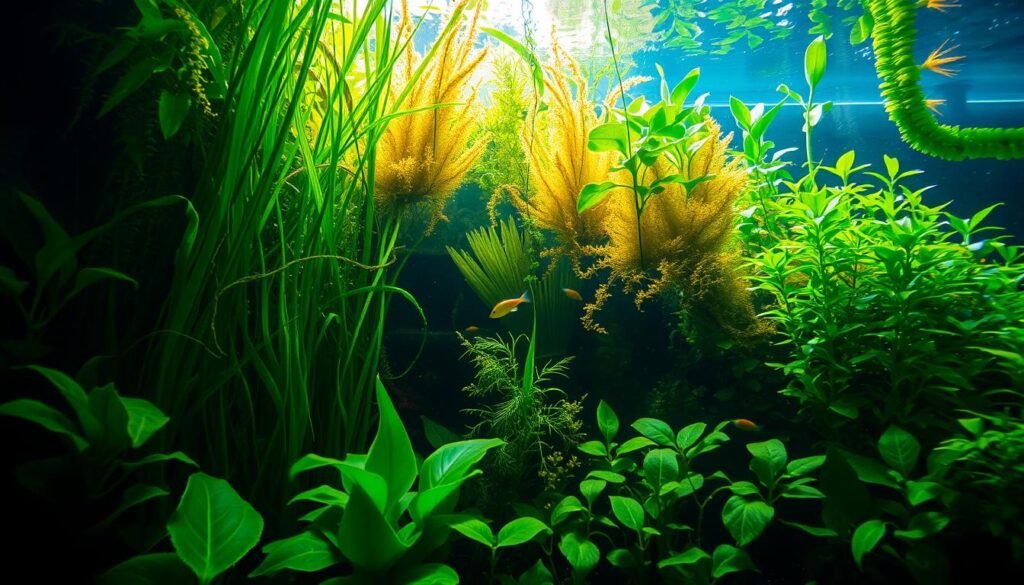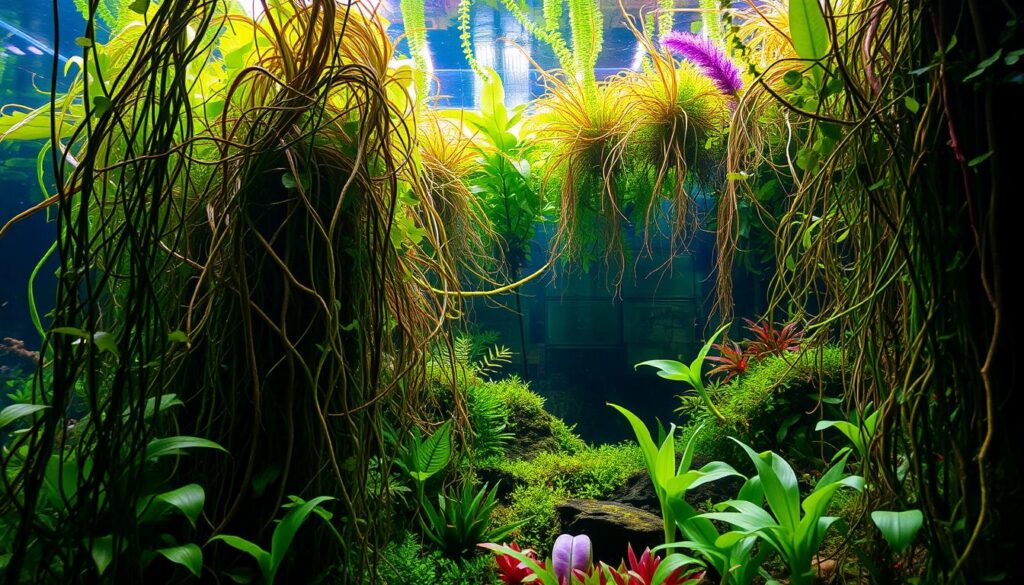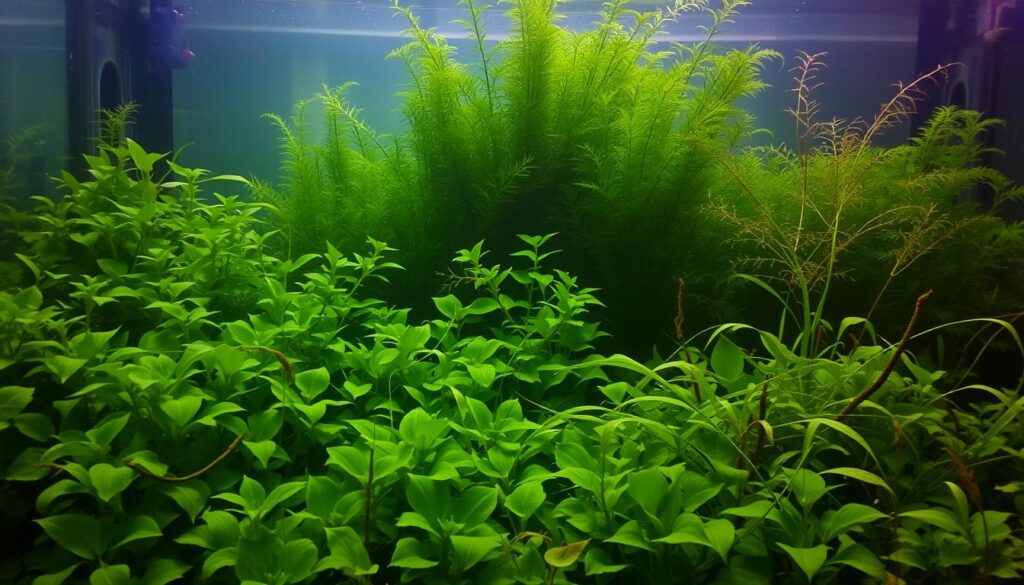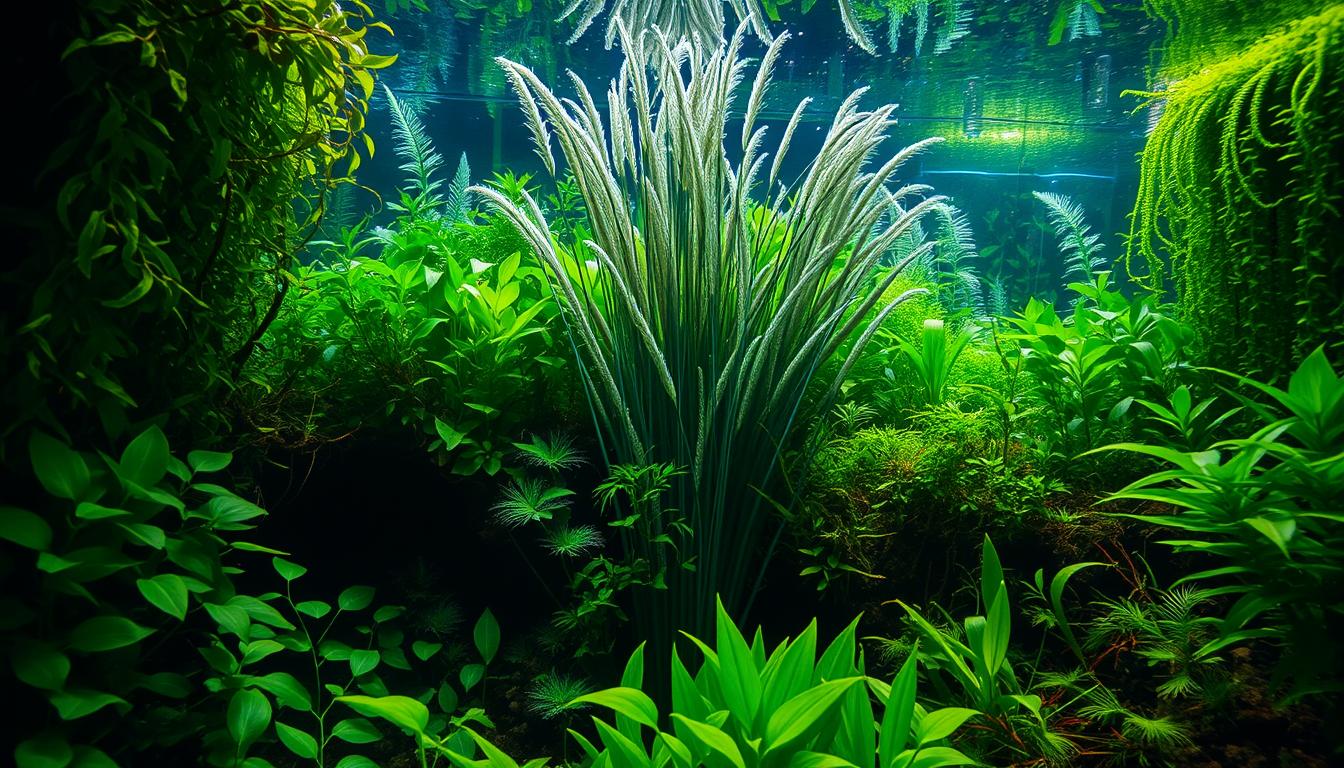Can you have too many plants in an aquarium? It’s a question many fishkeepers ask, especially when trying to create a lush, natural underwater environment. While live plants offer countless benefits like oxygen production and natural filtration, adding too many can lead to hidden challenges. In this article, we’ll explore whether it’s possible to overplant your tank, how it affects water quality and fish health, and how to strike the perfect balance for a thriving aquarium.
We know that plants and fish coexist harmoniously, contributing to each other’s well-being and reducing the necessary interventions. However, excessive plants can sometimes do more harm than good. So, how do you strike the right balance?
A well-balanced aquarium is a symphony of life, where plants and fish work together in harmony. By understanding how they interact, you can create a thriving environment that benefits both. Let’s dive in and explore the importance of finding that perfect balance!
Key Takeaways
- Aquariums need a balance between plants and fish to thrive.
- Excessive plants can harm the aquarium ecosystem.
- A balanced aquarium reduces the need for frequent interventions.
- Understanding the interaction between plants and fish is crucial.
- A well-balanced aquarium creates a healthy environment for both plants and fish.
The Role of Aquatic Plants in a Healthy Aquarium
Aquatic plants are the unsung heroes of a thriving aquarium, providing a multitude of benefits for both the tank’s ecosystem and its inhabitants. They play a crucial role in maintaining the delicate balance of the environment, and their importance cannot be overstated.
Biological Benefits of Aquarium Plants
Aquatic plants contribute significantly to the biological well-being of an aquarium. They are involved in several key processes that maintain water quality and promote a healthy environment.
Oxygen Production and Carbon Dioxide Consumption
Through photosynthesis, aquatic plants absorb CO2 and produce oxygen, enhancing the tank’s oxygen levels and benefiting the fish and other aquatic life.
Natural Filtration and Nutrient Cycling
Plants also act as natural filters, absorbing nutrients and waste products from the water, which helps to maintain optimal water parameters and reduce the need for artificial filtration methods.
Aesthetic Value of Planted Tanks
Beyond their biological benefits, aquatic plants add significant aesthetic value to an aquarium. They can be used to create natural habitats and enhance the visual appeal of the tank.
Creating Natural Habitats
By incorporating a variety of plant species, you can create a natural environment that mimics the fish’s natural habitats, reducing stress and promoting well-being.
Aquascaping Styles and Approaches
The art of aquascaping allows you to get creative with your tank’s design, using plants to create visually appealing layouts and arrangements that showcase your aquarium’s beauty.
Can You Have Too Many Plants in an Aquarium?
As you add more plants to your aquarium, you might wonder if there’s such a thing as too much greenery! While plants are essential for a healthy aquarium, providing numerous benefits for your fish and the overall ecosystem, there’s indeed a limit to how many you should have.

Defining “Too Many” in the Aquarium Context
“Too many” plants in an aquarium refers to a situation where the plant density starts to negatively impact the tank’s ecosystem or the well-being of its inhabitants. This can happen when the plants begin to overcrowd the tank, reducing swimming space for fish or causing water parameter changes due to excessive plant matter.
The Myth of Overplanting vs. Reality
Some aquarists believe that you can’t have too many plants, thinking that more plants mean a more natural environment. However, the reality is that overplanting can lead to issues such as reduced light penetration, increased CO2 consumption at night, and potential water quality problems. It’s about finding a balance that works for both your fish and plants.
Want to decorate your fish tank?
Check out the Ameliade Aquarium Plant & Rock Cave Set – perfect for goldfish and Betta tanks.
👉 Click here to buy now.
Balance Between Plant Mass and Tank Volume
Achieving the right balance involves considering the volume of your tank and the mature size of the plants you’re growing. A general rule of thumb is to ensure that your plants don’t occupy more than 50-60% of the tank’s volume. This allows for adequate swimming space and helps maintain water circulation and quality.
Managing plants in your aquarium effectively means being mindful of the fine line between a lush, planted tank and one that’s overcrowded with vegetation. By understanding the needs of both your plants and fish, you can create a thriving, balanced ecosystem.
Signs Your Aquarium Has Excessive Plant Growth
Too many plants in your fish tank can cause problems, but how do you know when you’ve reached that point? Excessive plant growth can lead to a range of issues, from reduced swimming space for your fish to changes in water parameters. Let’s dive into the signs that indicate your aquarium has excessive plant growth!
Visual Indicators of Plant Overcrowding
One of the most obvious signs of excessive plant growth is the visual impact it has on your aquarium. When plants become too dense, they can:
- Reduce the available swimming space for your fish
- Cause stunted growth in plants due to competition for resources
Reduced Swimming Space
If your fish are struggling to navigate through the dense foliage or seem to be avoiding certain areas, it’s likely that the plants have overcrowded the tank. Providing enough swimming space is crucial for the health and well-being of your fish.
Stunted Plant Growth
When plants become too crowded, they compete for light, nutrients, and CO2. This competition can lead to stunted growth or even the death of some plants. Regular pruning can help maintain a healthy balance.

Water Parameter Changes
Excessive plant growth can also affect the water parameters in your aquarium. Some key changes to watch out for include:
pH Fluctuations
Dense plant growth can cause significant fluctuations in pH levels, especially during the night when plants respire. This can be stressful for your fish.
Oxygen Depletion at Night
While plants produce oxygen during the day through photosynthesis, they consume oxygen at night. In a densely planted tank, this can lead to oxygen depletion, potentially harming your fish.
| Water Parameter | Daytime | Nighttime |
|---|---|---|
| Oxygen Levels | High | Low |
| pH Levels | Stable | Fluctuating |
Fish Behavior Changes
Fish behavior can be a good indicator of excessive plant growth. If your fish are:
- Stressed or lethargic
- Showing signs of disease or infection
- Altering their feeding habits
it may be due to the conditions caused by overcrowded plants.
By recognizing these signs, you can take corrective action to maintain a healthy balance in your aquarium. Regular monitoring and maintenance are key to ensuring that your plants and fish coexist happily.
The Science Behind Plant Density in Aquariums
Achieving the perfect balance of plant density is essential for creating a thriving aquarium ecosystem! You might wonder, what’s the big deal about plant density? Well, it’s quite simple really – the density of plants in your aquarium affects everything from gas exchange to light penetration, and ultimately, the overall health of your tank!
Understanding Plant Biomass and Tank Capacity
Plant biomass refers to the total mass of plants in your aquarium. When we’re talking about tank capacity, we’re not just referring to the volume of water it can hold, but also how much biological load it can handle. Too many plants can overload your tank’s capacity, leading to issues like decreased water quality!
“The key to a healthy aquarium is balance,” as many aquarists would agree. It’s not just about having a lot of plants, but having the right amount that works in harmony with other tank inhabitants.
Gas Exchange Considerations
Gas exchange is critical in an aquarium. Plants absorb CO2 and release O2 during photosynthesis, but they also consume O2 during respiration. A dense planting can lead to fluctuations in CO2 and O2 levels, affecting fish and other aquatic life!
Light Penetration and Shading Effects
Light is essential for plant growth, but too many plants can cause shading, reducing light availability for other plants. This can lead to uneven growth and potentially harm plants that require more light!
By understanding these scientific principles, you can better manage your aquarium’s plant density, creating a balanced and thriving environment for your aquatic friends!
Impact of Plant Overcrowding on Fish and Invertebrates
When it comes to aquarium plants, more isn’t always merrier – too many plants can have a significant impact on your fish and invertebrates! While plants are essential for a healthy aquarium, overcrowding can lead to a range of issues that affect the well-being of your aquatic life.
Swimming Space Restrictions
One of the most immediate effects of too many plants in your aquarium is the reduction of swimming space for your fish. Imagine being stuck in a crowded room with no way out – that’s what it can feel like for your fish when plants overgrow! This restriction can lead to stress and fatigue, making your fish more susceptible to disease.

Territorial Behavior Changes
Overcrowding with plants can also alter the territorial behavior of your fish. Some species may become more aggressive as they defend their territories from other fish and even from the encroaching plants themselves. This change in behavior can lead to a more stressful environment, potentially causing fin nipping, fighting, and other aggressive behaviors.
Feeding Challenges in Heavily Planted Tanks
Feeding your fish becomes a challenge when your tank is overcrowded with plants. Dense foliage can make it difficult for food to reach the bottom-dwellers or for you to monitor how much your fish are eating.
Food Competition
In a heavily planted tank, some fish might have a harder time competing for food, especially if the plants are attracting herbivorous fish or creating hiding spots for timid eaters. This competition can lead to malnutrition in some of your fish, affecting their overall health and vitality.
Difficulty Monitoring Fish Health
With too many plants, it can be challenging to keep an eye on your fish’s health. You might miss early signs of illness or injury, as the dense plant growth can hide your fish or make it harder to observe their behavior and condition.
| Issue | Effect on Fish/Invertebrates | Solution |
|---|---|---|
| Swimming Space Restrictions | Stress, Fatigue | Prune or remove excess plants |
| Territorial Behavior Changes | Aggression, Stress | Provide hiding places, Rearrange decor |
| Feeding Challenges | Malnutrition, Health Issues | Adjust feeding technique, Monitor closely |
By understanding the impact of plant overcrowding on your aquarium’s inhabitants, you can take steps to create a more balanced and healthy environment. Regular maintenance, careful planning, and a watchful eye can help you strike the perfect balance between lush plant growth and happy, healthy fish!
Balancing Plant Types for Optimal Aquarium Health
The key to a harmonious aquarium lies in balancing the different types of plants to create a thriving ecosystem. You see, having a variety of plants isn’t just about aesthetics; it’s about creating a balanced environment that benefits both your plants and your fish!
Fast-Growing vs. Slow-Growing Species
When selecting plants, it’s essential to consider their growth rates. Fast-growing species like Anacharis or Hornwort can quickly fill out your tank, providing shelter for your fish and helping to maintain water quality. On the other hand, slow-growing plants like Java Moss or Anubias offer stability and require less maintenance. By mixing both types, you can achieve a dynamic yet stable aquarium.
Floating Plants vs. Rooted Plants
Another crucial aspect is deciding between floating and rooted plants. Floating plants such as Duckweed or Water Wisteria help control algae by competing for nutrients and provide shade, reducing stress on your fish. Rooted plants, like Vallisneria or Cryptocorynes, stabilize the substrate and create hiding places for fish. A combination of both floating and rooted plants creates a layered, natural environment.
Considering Plant Size at Maturity
It’s vital to consider the mature size of your plants when planning your aquarium. This ensures that your tank doesn’t become overcrowded as your plants grow.
Small Foreground Plants
Small foreground plants like Dwarf Hairgrass or Globe Moss create a lush carpet without overshadowing other plants. They’re perfect for creating a visually appealing foreground.
Mid-ground and Background Species
Mid-ground and background plants, such as Amazon Swords or Java Fern, add depth to your aquarium. They can grow taller, providing a backdrop for your smaller foreground plants and creating hiding spots for your fish.
| Plant Type | Growth Rate | Placement |
|---|---|---|
| Anacharis | Fast | Floating or Background |
| Java Moss | Slow | Foreground or Mid-ground |
| Vallisneria | Fast | Background |
By balancing different plant types and considering their growth rates, sizes, and placements, you can create a vibrant, healthy aquarium that thrives. So, take the time to plan your plant selection carefully, and you’ll be rewarded with a beautiful, balanced aquatic environment!

Maintenance Challenges of Densely Planted Aquariums
Diving into the world of densely planted aquariums can be a thrilling adventure, but it comes with its own set of maintenance challenges! As beautiful as these tanks are, they require regular upkeep to keep them thriving.
Pruning Requirements and Schedules
One of the most significant maintenance tasks for densely planted aquariums is pruning. Plants like Anacharis and Cabomba can grow rapidly, requiring regular trimming to prevent overcrowding.
Weekly vs. Monthly Maintenance Tasks
To keep your tank looking its best, you’ll need to perform both weekly and monthly tasks. Weekly tasks might include quick trims of fast-growing plants, while monthly tasks could involve more extensive pruning and rearranging.
Tools for Effective Plant Management
Investing in the right tools can make a big difference. Use sharp scissors or pruning shears to trim plants, and consider a gravel vacuum to clean up debris.
Water Change Considerations
Regular water changes are crucial in densely planted tanks. Not only do they help maintain water quality, but they also provide an opportunity to check on plant health and remove any dead or dying vegetation.
Substrate Maintenance in Plant-Heavy Tanks
The substrate in a densely planted tank can become a hotbed of activity, with roots growing and decomposing organic matter. Regularly cleaning the roots and fertilizing as needed can help keep your plants healthy.
Root Cleaning
Gently cleaning the roots of your plants can help prevent the buildup of debris and promote healthy growth. Be careful not to damage the roots during this process.
Fertilization Needs
Densely planted tanks often require additional fertilization to support plant growth. Monitor your plants’ needs and adjust your fertilization schedule accordingly.
By staying on top of these maintenance tasks, you can enjoy a lush, thriving aquarium that’s the envy of any aquarist. Remember, the key to success lies in finding that delicate balance between plant growth and tank maintenance.
Lighting and CO2 Requirements for Plant-Dense Tanks
Achieving the perfect balance in a densely planted aquarium requires careful consideration of lighting and CO2 levels. You might wonder, what’s the big deal about lighting and CO2? Well, let’s dive in!
Balancing Light Intensity with Plant Mass
Too little light, and your plants will struggle to photosynthesize. Too much, and you’ll be dealing with algae blooms. It’s all about finding that sweet spot! For instance, if you’re using high-light plants, you’ll need to adjust your lighting accordingly to prevent over-illumination.
CO2 Supplementation for Heavily Planted Aquariums
CO2 is crucial for plant growth, and in densely planted tanks, supplementation is often necessary. You have two main options: DIY CO2 systems or pressurized CO2 systems.
DIY vs. Pressurized CO2 Systems
DIY systems can be cost-effective but require more maintenance. Pressurized systems, on the other hand, offer more stability but at a higher upfront cost.
Monitoring CO2 Levels
It’s essential to monitor CO2 levels to ensure they’re within the optimal range for your plants. This can be done using CO2 drop checkers or more advanced monitoring systems.
Avoiding Algae Blooms in Plant-Rich Environments
Algae blooms can be a sign of imbalance in your tank. Here’s a simple table to help you identify potential causes:
| Cause | Effect | Solution |
|---|---|---|
| Excessive Lighting | Algae Growth | Adjust Lighting Schedule |
| Insufficient CO2 | Plant Stress | Increase CO2 Supplementation |
| Poor Water Circulation | Dead Spots for Plants | Improve Water Circulation |
By balancing lighting and CO2 levels, you can create a thriving environment for both your plants and fish. Happy aquarium keeping!
Strategies for Thinning Overgrown Aquarium Plants
When your aquarium plants start to take over, it’s time to thin them out for a healthier tank! Managing excessive plant growth is crucial for maintaining a balanced underwater ecosystem. Overgrown plants can lead to reduced water quality, increased competition for resources, and even harm to your fish. In this section, we’ll explore effective strategies for thinning out overgrown aquarium plants.
Selective Pruning Techniques
Pruning is a vital maintenance task for keeping your aquarium plants under control. By selectively pruning your plants, you can encourage healthy growth and prevent overcrowding.
Stem Plant Trimming
Stem plants, like Cabomba or Ludwigia, can grow rapidly and become quite dense. To trim stem plants, simply cut back the stems to the desired height using a pair of sharp scissors or pruning shears. Make clean cuts just above a node to promote new growth.
Rosette Plant Management
Rosette plants, such as Echinodorus species, grow by producing new leaves from a central crown. To manage rosette plants, remove any dead or dying leaves and trim back overgrown foliage to maintain shape and promote healthy growth.
Plant Removal and Rehoming Options
Sometimes, pruning isn’t enough, and you need to remove entire plants to prevent overcrowding. But what do you do with the excess plants?
Selling or Trading Excess Plants
If you have a surplus of healthy plants, consider selling or trading them with other aquarium enthusiasts. You can join online forums or local aquarium clubs to connect with potential buyers or traders.
Starting New Tanks
Another great option is to use your excess plants to start new tanks or supplement existing ones. This can be a cost-effective way to create a new aquarium or refresh an old one.
Replanting and Rearranging for Better Balance
After thinning out your plants, it’s essential to replant and rearrange the remaining vegetation to achieve a balanced look. Consider the mature size of your plants and leave enough space for growth.
Here’s a simple table to help you plan your aquarium planting:
| Plant Type | Mature Size | Growth Rate |
|---|---|---|
| Stem Plants | Variable | Fast |
| Rosette Plants | Variable | Slow to Medium |
| Floating Plants | Variable | Fast |
By following these strategies, you can maintain a healthy and balanced aquarium with a variety of plants that thrive together.
Designing a Sustainable Planted Aquarium from the Start
Creating a thriving planted aquarium starts with a thoughtful design that balances plant growth with the needs of your fish! When you’re setting up your tank, it’s easy to get carried away with adding plants, but a little planning goes a long way in creating a sustainable underwater ecosystem.
Planning for Plant Growth and Spread
One of the most critical aspects of designing a planted aquarium is planning for how your plants will grow and spread. Some plants can grow quite rapidly, while others remain compact. Understanding the mature size of your plants and their growth habits will help you create a balanced and visually appealing layout.
Selecting Compatible Plant Species
Choosing the right plants for your aquarium involves more than just picking your favorites. You need to consider factors like growth rates, lighting requirements, and compatibility with your fish. For instance, some plants are better suited to low-light conditions, while others require intense illumination.
Considering Growth Rates
Fast-growing plants can help stabilize your tank’s ecosystem by consuming excess nutrients, but they may require more frequent pruning. On the other hand, slow-growing plants are often less demanding but may not provide the same level of nutrient uptake.
Matching Plants to Your Maintenance Schedule
If you’re a busy aquarist, you’ll want plants that are forgiving and require less maintenance. Conversely, if you’re willing to prune and replant regularly, you can incorporate a wider variety of plants into your design.
Creating Maintenance-Friendly Layouts
A well-designed aquarium isn’t just about aesthetics; it’s also about creating a layout that’s easy to maintain. This includes leaving access paths for cleaning and strategically placing fast-growing species where they won’t overshadow slower-growing plants.
Access Paths for Cleaning
By leaving some space between plantings, you can easily reach into your tank to clean or prune plants without having to remove everything.
Strategic Placement of Fast-Growing Species
Placing fast-growing plants in areas where they won’t shade out other plants or obstruct fish swimming paths will help maintain a balanced ecosystem.
| Plant Type | Growth Rate | Lighting Needs |
|---|---|---|
| Java Moss | Slow | Low-Moderate |
| Amazon Swords | Moderate | Moderate-High |
| Hornwort | Fast | Low-High |
By considering these factors and planning your planted aquarium carefully, you can create a thriving, sustainable environment that brings joy to you and a healthy home to your fish!
Conclusion: Finding Your Aquarium’s Perfect Plant Balance
So, can you have too many plants in an aquarium? The answer is yes, but it’s not just about the number of plants – it’s about balance! Aquarium plant overcrowding can lead to a range of issues, from reduced water quality to stressed-out fish. By understanding the role of plants in your aquarium and managing them effectively, you can create a thriving ecosystem that’s both beautiful and healthy.
Managing plants in your aquarium is an ongoing process. It requires regular maintenance, including pruning and monitoring water parameters. By striking the right balance, you’ll be rewarded with a lush, vibrant environment that benefits both your plants and fish. So, take the time to assess your aquarium’s plant population and make adjustments as needed – your aquatic friends will thank you!
With the right approach, you can enjoy the many benefits of a planted aquarium while avoiding the pitfalls of overcrowding. By being mindful of plant density, selecting the right plant species, and maintaining a balanced ecosystem, you’ll be well on your way to creating a stunning underwater world that’s a joy to behold.

